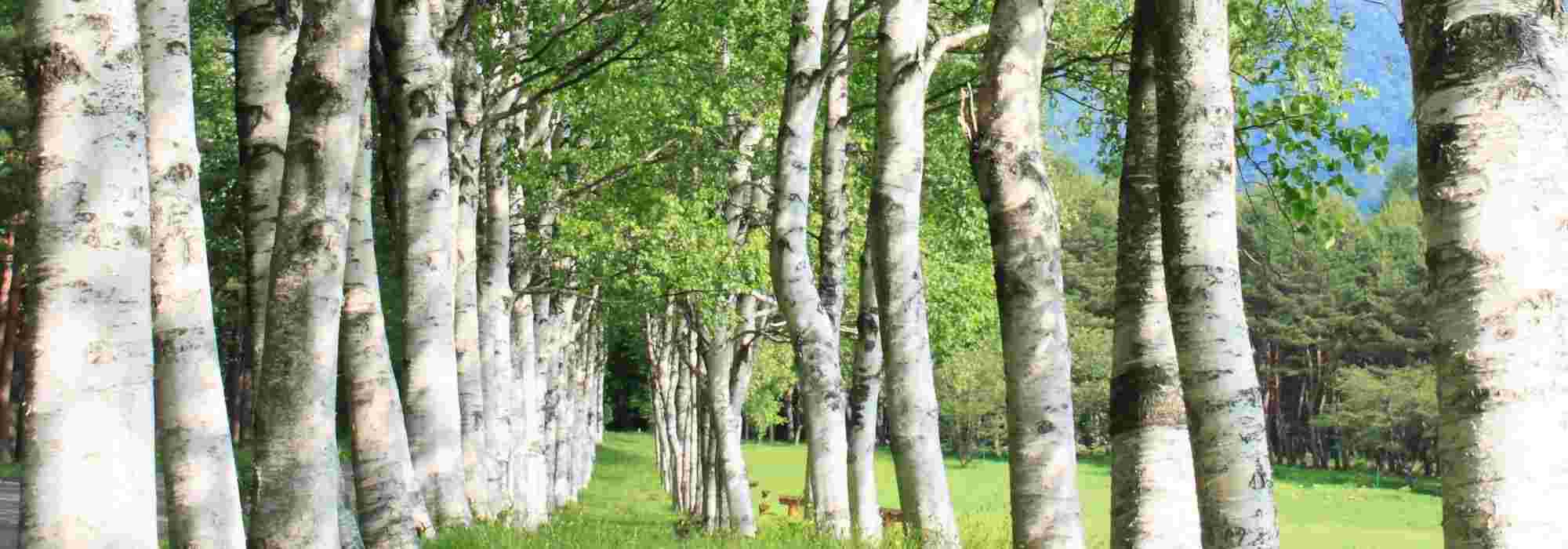
Associate the birches
Our inspirations to enhance its bark
Contents
Lightly silhouetted tree, the birch can fit into many associations. Its bark is a decorative element throughout the year, making it suitable for beautiful winter or autumn gardens. Whether in a modern and trendy garden, a more classic English garden, or as a standalone, birches know how to attract attention with their vertical trunks in various colours, their diverse habits, and their foliage, which can vary significantly from one species or variety to another. To find the right companions for this deciduous tree, discover our 6 association ideas!
For more information on their cultivation, feel free to check our sheet on Birches: planting, pruning, and maintenance.
In a winter setting
Currently in vogue, winter gardens are a concept that originated in England. These landscaping features are appealing for their winter colours. For many, winter is a dreary time in the garden. By utilising all the decorative resources of plants, it is possible to restore the garden’s vibrancy. Indeed, the birch is a deciduous tree that loses its foliage in winter, but it remains very interesting for its bark. The Chinese Birch with its coppery trunk, the very white Betula utilis jacquemontii, and the dark Betula nigra are among the most remarkable specimens. Pair them with trees or shrubs that bloom in winter (such as witch hazel, the highly fragrant Chimonanthus praecox), featuring very colourful naked wood in winter (decorative wood dogwood, golden willow, or red osier, Rubus thibenatus ‘Silver Fern’) or even those bearing eye-catching fruits (beautyberry, ornamental apple ‘Red Sentinel’ or ‘Evereste Perpetu’). Retaining their needles in winter, colourful conifers (green, blue, or golden) are also welcome. The tall, dried, and upright culms of certain grasses help to warm the atmosphere with their straw-yellow colour (Miscanthus, Panicum). Finally, many hardy perennials can remain in bloom during winter: winter heather Erica darleyensis ‘Tyann’, snow heather ‘Springwood White’, ‘Christmas Rose’.

Chimonanthus praecox (photo PBK), Betula albosinensis ‘Fascination’, Malus ‘Perpetu Evereste’, Cornus sanguinea ‘Winter Beauty’, Erica darleyensis ‘Springwood White’, Picea pungens ‘Glauca Globosa’
Read also
Birches: planting, pruning and careIn a modern and minimalist garden
The white bark of the birch is a beautiful asset for the layout of a modern garden. For a successful graphic effect, the lines of the garden must be well defined. Plant your vegetation symmetrically and choose plants with naturally geometric shapes or that can be pruned to your liking. This decor is minimalist and understated, featuring green and white to bring a sense of serenity. One of the birches with the whitest trunk is the Himalayan birch (or its variety ‘Doorenbos’). This can have a single trunk or be many-stemmed (with several trunks), which does not detract from its beauty. With variegated green foliage, the Betula nigra ‘Shiloh Splash’ in a pyramidal shape can also fit into this combination. Feel free to install dwarf conifers in pots (in ball shapes like Pinus strobus ‘Minuta’, Pinus mugo ‘Picobello’ or Platycladus orientalis ‘Aurea Nana’ with a conical habit). Among the shrubs, consider hydrangeas that bear flat or conical round inflorescences. The famous Hydrangea arborescens ‘Annabelle’, whose green flowers gradually turn white, is a very good example here. Let the spherical blooms of a white agapanthus dominate above the green foliage of Lonicera nitida or the Ilex crenata, pruned into rounded or square topiary. Finally, a grass with fine foliage (Stipa tenuissima, Stipa pennata, Pennisetum orientale ‘JS Dance With Me’), adds a touch of lightness and softness to this highly structured scene.

Hydrangea ‘Annabelle’, Betula utilis var. jacquemontii ‘Doorenbos’ (photo w cutler), Agapanthus ‘Double Diamond’, Platycladus orientalis ‘Aurea Nana’, Lonicera nitida and Stipa tenuissima
Discover other Betula - Birch tree
View all →Available in 1 sizes
Available in 1 sizes
Available in 2 sizes
Available in 1 sizes
Available in 2 sizes
Available in 1 sizes
Available in 2 sizes
Available in 1 sizes
Available in 1 sizes
Available in 1 sizes
In an autumn garden
With foliage displaying beautiful golden hues in autumn, the birch offers a stunning spectacle in the late season. During this time when sunlight diminishes, plants prepare to face winter, taking on shades of yellow, orange, red, or pink. Pair your birch with trees that boast beautiful autumn colours, such as the maple Acer palmatum ‘Orange Dream’ with its yellow-orange foliage or the ‘Forest Pansy’ redbud that turns rust in autumn. Very colourful shrubs can also be included in this arrangement: the Cotinus coggygria ‘Golden Spirit’ turning to copper-red, the vibrant Euonymus grandiflorus ‘Red Wine’ with leaves transitioning from orange to red, then to purplish, and the Cornus florida ‘Cherokee Daybreak’ with variegated green, pink, and white foliage. Don’t forget the evergreen Mahonia ‘Soft Caress’, renowned for its yellow flowering. Some perennials bloom during this period: autumn asters (like the Aster laevis), the autumn stonecrop (cultivar ‘Herbstfreude’ for example). The foliage of perennials can also have decorative interest. Heucheras come in many colours. The variety ‘Forever Purple’ creates a beautiful contrast with the orange foliage of trees and shrubs. Less well-known, the Gillenia trifoliata and Darmera peltata dress in fiery colours for one and reddening leaves for the other.
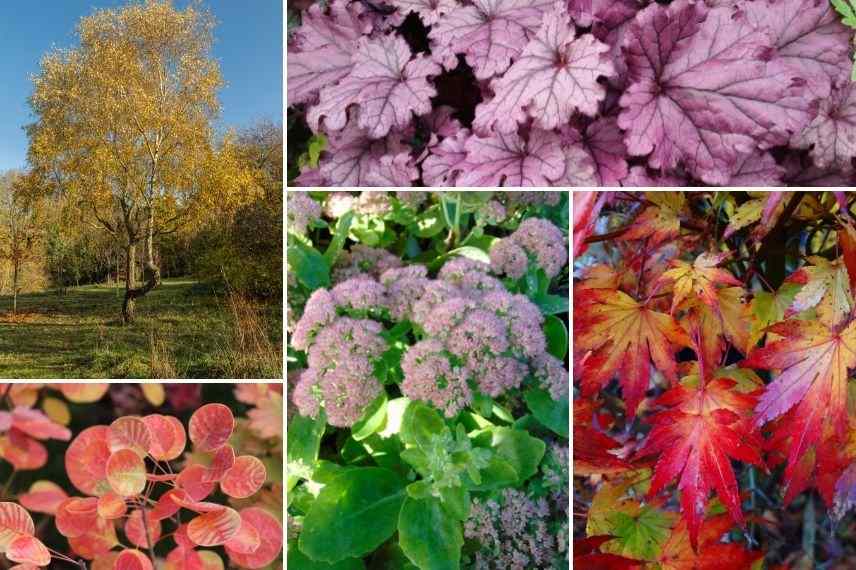
Birch with yellow autumn foliage, Heuchera ‘Forever Purple’, Cotinus coggygria ‘Golden Spirit’ (photo Beervelde), Sedum ‘Herbstfreude’ and Acer palmatum ‘Orange Dream’
Read also
7 amazing birches to discoverIn isolation with a few companion plants
The birch does not necessarily need to be planted with other trees and bushes to stand out. Thanks to its majestic habit and beautiful bark, it is a highly decorative element on its own. The Himalayan birch with its very white bark or the Betula pendula ‘Royal Frost’, which boasts purple foliage, are well suited for solitary planting. We should also mention the weeping birches ‘Crispa’, ‘Tristis’, and ‘Youngii’ with their pendulous branches and white bark. To brighten up a tree planted alone, it is advisable to plant groundcover and/or bulbous plants at its base. However, keep in mind that the birch has a shallow root system, and the plants that will be placed under this tree must be well resistant to root competition. Additionally, regular pruning of the very long pendulous branches will be necessary to ensure that the ground plants are visible. Preferably choose evergreen plants that thrive in semi-shaded conditions. With its white spring flowering from April to June, the sweet woodruff can be combined with the mauve flowers of the small variegated periwinkle. Also consider the hardy geranium, which has a wide variety of flowering options, and the Pachysandra terminalis, which forms beautiful carpets of vegetation. For bulbous plants, the snowdrop, Chionodoxa forbesii ‘Blue Giant’, the Cyclamen coum pink, and the bluebell are all quite suitable and allow for a succession of blooms from January to May. The pink Naples cyclamen or white can take over with its flowering from August to October.

Gallium odoratum, Chionodoxa forbesii ‘Blue Giant’, Cyclamen ‘Coum’ and Weeping Birch ‘Youngii’
In a perennial bed in English garden style
For this English-style border, ensure a planting in layers of different heights. Regarding perennial plants, they must have good resistance to the roots of birch. At the back of the border, well set back, the birch adds verticality to the arrangement, for example: the paper birch planted in coppice of 3 specimens, the fastigiate birch Betula pendula ‘Fastigiata’ or the black birch Betula nigra ‘Heritage’. Ensure that these trees in the background are positioned so as not to cast total shade on the perennial plants. At their base, install the large Acanthus mollis ‘Latifolius’ which thrives in areas where few plants survive. Accompany it with Japanese anemones ‘Margarete’ and ‘September Charm’. About 1 m tall, they enhance the garden with their soft pink flowers. Smaller, the Hesperis matronalis ‘Alba’ offers a brilliant white flowering from May to July. The smaller bushy birches are perfect at the heart of a border with cool soil. Opt for Betula nana or its golden variety Betula nana ‘Golden Treasure’ which coexist with common lady’s mantle with its very fresh green leaves and its flowering in a cloud of yellow-green flowers. The bleeding heart Dicentra spectabilis, too, does not fear the shallow roots of birch. It is a classic of English gardens. Pink, white, or blue, woodland sage can also grow near trees with superficial roots (Salvia nemorosa ‘Amethyst’, Salvia nemorosa ‘Schneehügel’, Salvia nemorosa ‘Caradonna’). At the front, the tiarelle ‘Morning Star’ about 30 cm tall decorates the border of the bed with its pink spike flowers and its bicoloured green and brown foliage, accompanied by the Campanula pulla with a creeping habit.

Anemone ‘September Charm’, Coppiced birch, Dicentra spectabilis (photo pixabay), Salvia nemorosa ‘Amethyst’, Alchemilla mollis (photo Anneli Salo) and Campanula pulla
In a grove in a large garden
Owners of large gardens can create their own collection of birches with different barks by grouping them in a grove. For a more natural effect and a more interesting perspective on biodiversity, nothing beats a grove composed of trees from different genera. Prefer local species that are better suited to the medium. About ten metres tall with golden foliage, combine the verrucate birch ‘Golden Cloud’ with trees of approximately similar height at ripeness: common hornbeam (Carpinus betulus ‘Orange Retz’), black locust, glutinous alder (for example, the variety ‘Imperialis’), field maple, bird cherry, walnut (varieties ‘Parisienne’ or ‘Franquette’), field elm, or Henry’s lime. You can also add a few shrubs to your grouping of trees, such as rowan or hazel.

Foliage of Acer campestre and Ulmus minor suberosa (photo Wikipedia), Hornbeam ‘Orange Retz’, Betula pendula and Alnus glutinosa ‘Imperialis’ (photo Wikipedia)
- Subscribe!
- Contents
































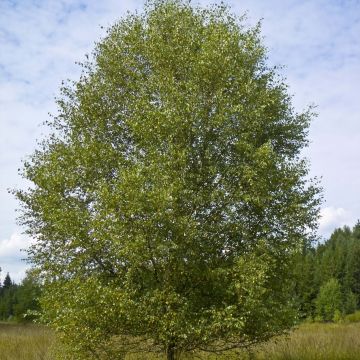
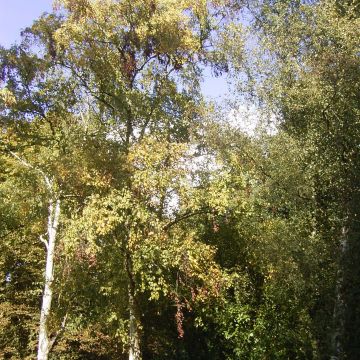
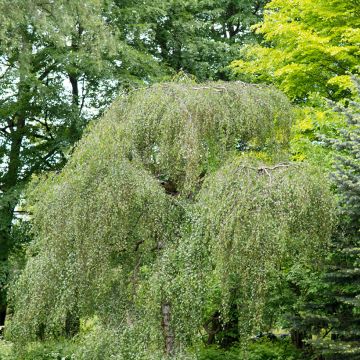
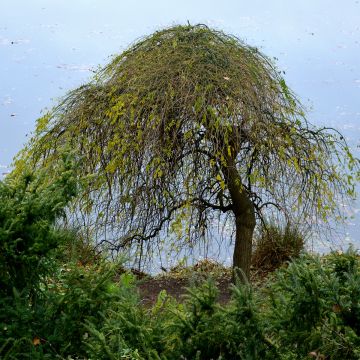

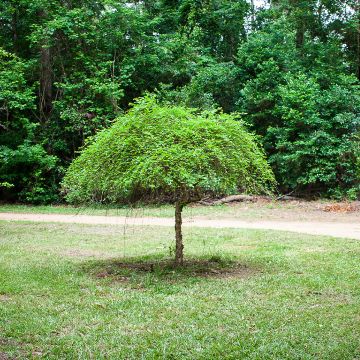

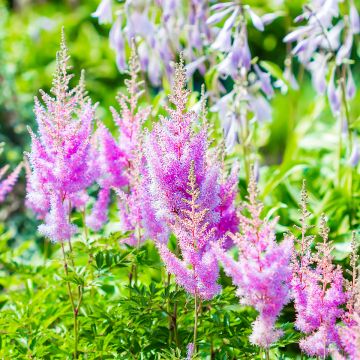

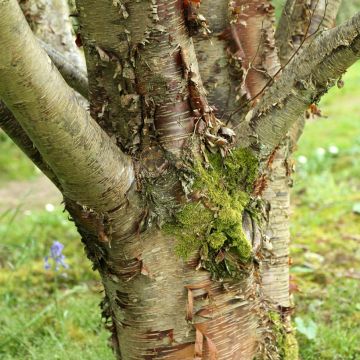
Comments